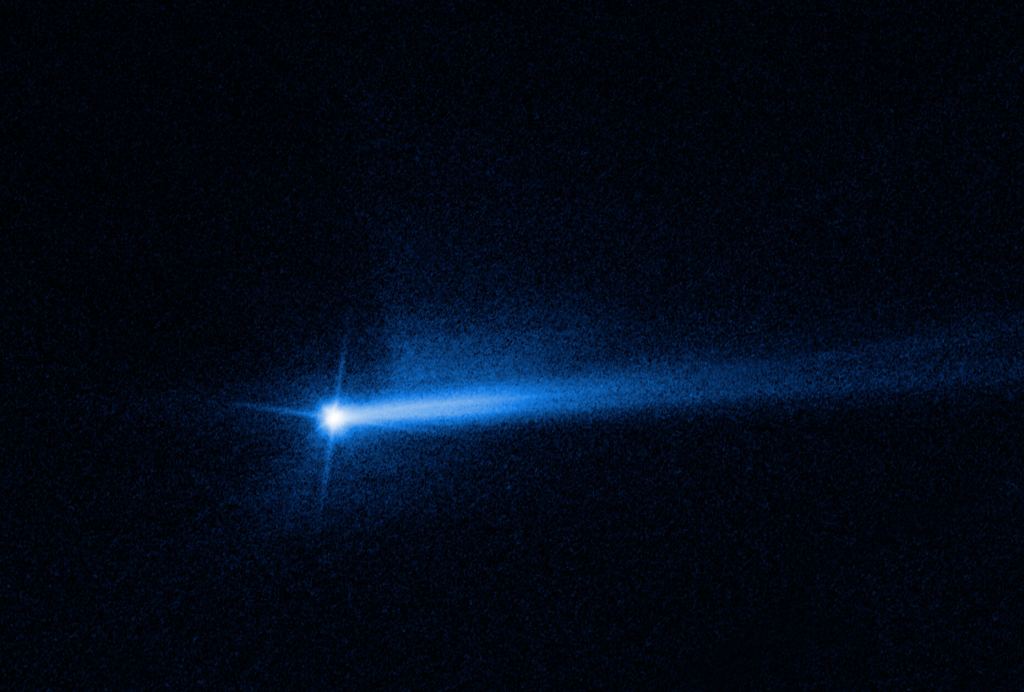A worldwide team of dedicated observers ‘stood in the shadow’ of asteroid Didymos recently, as it passed in front of a distant star.
Amateur astronomers continue to provide key scientific observations, even in the modern era. This was highlighted recently, when a team of dedicated observers caught a series of occultation of a distant stars involving asteroid 65803 Didymos.
The asteroid made space headlines recently, when NASA’s DART (Double Asteroid Redirection Test) was deliberately slammed into the asteroid’s tiny moon Dimorphos.
 Pow! The DART impact on Dimorphos, captured by the Italian Space Agency’s LICIACube mission. Credit: the Italian Space Agency
Pow! The DART impact on Dimorphos, captured by the Italian Space Agency’s LICIACube mission. Credit: the Italian Space AgencyThe DART impact occurred on September 26, 2022, as the 610 kilogram spacecraft slammed into Didymos’ tiny 170-metre in diameter moonlet, Dimorphos. The impact shorted the 11 hour, 55 minute orbit of the asteroid by 32 minutes—three times greater than expected. Recent Hubble observations have also revealed that the impact has turned the asteroid into a temporary comet, sporting a long twin tail.
 Two tails of dust ejected from the Didymos-Dimorphos asteroid system are seen in new images from the NASA/ESA Hubble Space Telescope. Credit: NASA/HST/STScI.
Two tails of dust ejected from the Didymos-Dimorphos asteroid system are seen in new images from the NASA/ESA Hubble Space Telescope. Credit: NASA/HST/STScI.Why Occultations Are Important
Occultations occur when one astronomical object ‘occults’ or passes in front of another. These generally involve the Moon, planets, or—in the case of Didymos—an asteroid passing in front of a star. If enough observers are placed along the expected path of the event, a shadow-shape of the occulting body can be drawn, outlining a silhouette showing the shape and position of the asteroid in space.
Earth-based occultation observations were used to characterize 486958 Arrokoth (known as 2014 MU69 at the time), prior to New Horizons’ 2019 flyby. Efforts are also underway to catch Jupiter Trojan asteroid occultations ahead of the arrival of NASA’s Lucy mission in 2027 to 2033. One campaign has already paid off, discovering a small moonlet for asteroid 15094 Polymele.
 Observations of the occultation of a distant star by asteroid Polymele, revealing a moonlet tentatively named ‘Shaun.’ Credit: SwRI/Buie/Kretke.
Observations of the occultation of a distant star by asteroid Polymele, revealing a moonlet tentatively named ‘Shaun.’ Credit: SwRI/Buie/Kretke.These observations aren’t easy. For useful results, the observers need to know their precise location, and achieve accurate timing of when the star faded out and brightened. They also need to know when and were the path of the asteroid shadow along the face of the surface of the Earth will occur. Position yourself too far north or south of the path, and you’ll see…nothing.
This sort of extreme precision also means that, until about a generation ago, less than a dozen asteroid occultations were reliably observed. These sorts of observations had to wait for faster computing power and astrometry missions measuring the precise parallax of stars, such as Hipparcos, and the European Space Agency’s (ESA) Gaia Space observatory.
To target fast-moving Near-Earth Asteroids (NEAs), the ESA formed a Discovery program through their Open Space Innovation Platform, dubbed the Asteroid Collaborative Research via Occultation Systematic Survey, or ACROSS. The ACROSS campaign melds the efforts of citizen scientists, professional and amateur astronomers in a truly pro/am collaboration.
“Astrometry based on observing ‘stellar occultations’ was initially exploited for asteroids in the main belt between Mars and Jupiter, then Trans-Neptunian objects,” says Paolo Tanga (ACROSS project leader) in a recent press release. “ACROSS is extending its systematic exploitation to Near-Earth asteroids as well. This is the challenge: because NEA’s move fast and are small, thus producing shorter events and much narrower shadows projected on the ground.”
This is a huge logistical undertaking. This became apparent during an effort to observe a Didymos occultation on August 25th about a month before the DART impact, when weather thwarted observations across Portugal, Spain and Algeria.
Undeterred, the team hit pay dirt just last week, nabbing some of the first occultations of Didymos post DART impact. First up, Robert Dunford caught an event lasting just 0.13 seconds while observing from northern Oklahoma. Then, three nights later, Jose-Luis Ortiz caught an event that matched predictions while observing from near Granada, Spain. Finally, a Japanese team led by Hayato Watanabe and Kiyoshi Ida spied a pair of events from two separate sites, via the Japan Occultation Information Network (JOIN).
 A dip in brightness for a distant background star, revealing the shadow of asteroid Didymos. Credit: ESA/ACROSS/Miguel Sanchez.
A dip in brightness for a distant background star, revealing the shadow of asteroid Didymos. Credit: ESA/ACROSS/Miguel Sanchez.Observations of Didymos will help to not only refine its orbit, but could also actually detect a possible ‘wobble’ on its path around the Sun induced by DART’s impact on Dimorphos.
This will also inform ESA’s Hera mission, which will launch in 2024 and head to the Didymos-Dimorpos asteroid system.
Amateur collaboration with professional astronomy is alive an well, as observers on Earth continue to provide vital support to missions in deep space.
Lead Image: An amateur astronomer sets up to catch an occultation. ESA/ACROSS/Instituto de Astrofisica de Andalucia/CSIC.

